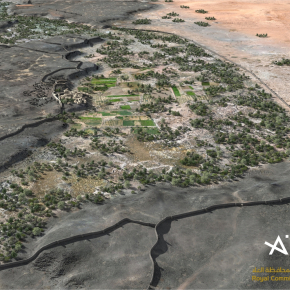
Discovery of immense fortifications dating back 4,000 years in north-western Arabia
The North Arabian Desert oases were inhabited by sedentary populations in the 4th and 3rd millennia BCE. A fortification enclosing the Khaybar Oasis—one of the longest known going back to this period—was just revealed by a team of scientists from the CNRS1 and the Royal Commission for AlUla (RCU). This new walled oasis is, along with that of Tayma, one of the two largest in Saudi Arabia. While a number of walled oases dating back to the Bronze Age had already been documented, this major discovery sheds new light on human occupation in north-western Arabia, and provides a better grasp of local social complexity during the pre-Islamic period.
Cross-referencing field surveys and remote sensing data with architectural studies, the team estimated the original dimensions of the fortifications at 14.5 kilometres in length, between 1.70 and 2.40 metres in thickness, and approximately 5 metres in height. Preserved today over a little less than half of its original length (41%, 5.9 km and 74 bastions), this colossal edifice enclosed a rural and sedentary territory of nearly 1,100 hectares. The fortification’s date of construction is estimated between 2250 and 1950 BCE, on the basis of radiocarbon dating of samples collected during excavations.
While the study confirms that the Khaybar Oasis clearly belonged to a network of walled oases in north-western Arabia, the discovery of this rampart also raises questions regarding why it was built as well as the nature of the populations that built it, in particular their relations with populations outside the oasis.
This archaeological discovery, whose results were published on 10 January in the Journal of Archaeological Science: Reports (JASREP), paves the way for major advances in understanding the prehistoric, pre-Islamic, and Islamic past of the north-western Arabian Peninsula.
- 1From the Orient and Mediterranean Laboratory (CNRS/Collège de France/EPHE-PSL/Sorbonne Université/Université Panthéon-Sorbonne) and the Archéorient – Environments and Societies of the Ancient East Laboratory (CNRS/Université Lumière Lyon 2), in connection with the Khaybar Longue Durée Archaeological Project commissioned by the French Agency for AlUla Development (AFALULA) for the Royal Commission for AlUla (RCU).
The ramparts of Khaybar. Multiproxy investigation for reconstructing a Bronze Age walled oasis in Northwest Arabia. Guillaume Charloux, Shadi Shabo, Guillaume Chung-To, Bruno Depreux, François Guermont, Kévin Guadagini, Thomas Terrasse, Mylène Bussy, Saifi Alshilali, Diaa Albukaai, Rémy Crassard and Munirah AIMushawh. Journal of Archaeological Science : Reports, January 10, 2024.
DOI : https://doi.org/10.1016/j.jasrep.2023.104355

